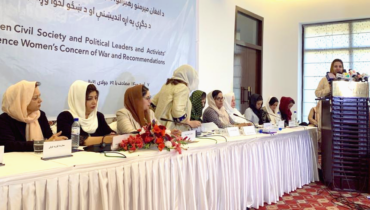Originally posted on The Carter Center’s Forum on Women blog.
Of the 455 publicly identified men and women who have traveled or attempted to travel to Syria to fight with a terrorist organization, 36 are women from the West. The average age of these women is 18 years old. What lures young Western women to join extremist movements? It is a question that has not yet been given the attention it deserves.
To successfully counter violent extremism, efforts must seek to understand what attracts women to join such movements, not solely writing it off as mental illness or an attraction to trivialities. CNN recently came under fire for stating that the Islamic State in Iraq and Syria (ISIS) uses “Nutella and kittens” to attract Western women to its call for violent jihad. Experts assert the pull is much more complex: “Believe it or not, women can be susceptible to ideologies too,” stated one panelist at the Global Center on Cooperative Security’s Roles of Women and Youth in Preventing and Countering Violent Extremism.
On January 23, 2015, Shannon Maureen Conley became the first woman in America to be sentenced for conspiracy to support ISIS. Conley was found in violation of Title 18 of the United States Code Section 2339B, “Providing and Attempting to Provide Material Support or Resources to a Designated Foreign Terrorist Organization.”
The Affidavit supporting Conley’s criminal complaint and arrest warrant details Conley’s conversations with FBI Special Agents. In those eightinterviews, Conley repeatedly identified that she wanted to go overseas and wage jihad—either as a combatant or a medical assistant in the field. (Byrne Aff. ¶6). She continued to affirm her plan to join extremist efforts abroad, despite warnings from the special agents regarding the illegality of her intended actions that could result in her arrest: “When asked if she still wanted to carry out the plans, knowing they are illegal, Conley said that she does.” (Byrne Aff. ¶7). Conley told the special agents “she would rather be in prison than do nothing.” (Byrne Aff. ¶ 11). Conley also shared that she met a 32 year-old male online who was fighting for ISIS in Syria whom she planned to marry. (Byrne Aff. ¶¶ 17-18). Conley was arrested at the airport on April 4, 2014.
While Judge Raymond P. Moore acknowledged during the trial that “[Conley] is in need of psychiatric help,” and “I’m not saying that her decisions were all a product of mental illness…But she’s a bit of a mess,” he sentenced Conley to a four-year prison sentence to deter others from joining ISIS. We must ask how much of a deterrent effect this sentence will have on other young women. After all, Conley received numerous warnings from FBI agents that her plans were illegal, but she was not dissuaded. The way in which ISIS treats non-Muslim female slaves, “kidnapping, selling and raping women and children,” or beheads journalists and other hostages, has also not deterred the young girls that continue to leave their homes to join the extremist group they fervently support. What benefit do young women see in waging violent jihad, in defending a radical interpretation of Islam “that seeks to install a Taliban-style utopia that will ensure you can never have a job or get an education”?
Rather than using one young woman’s prison sentence in hopes of deterring others from joining ISIS, more research is needed on why these women are drawn to extremist ideology in the first place. We must be wary of attributing this attraction to the frivolities of “Nutella and kittens” because “it denies women any political agency…[and] it infantilizes them in a way that you would assume they would be drawn to this for the most superficial reasons,” according to Nimmi Gowrinathan, a visiting professor at the Colin Powell Center for Civic and Global Leadership at City College, New York.
There is an ideological element that often goes ignored—especially in the case of young women, where they are cast aside as “mentally unstable,” or characterized as leaving “to marry the jihadist militant of their dreams.” However, the search for a sense of belonging is an underlying factor that must be examined: “[ISIS is] targeting the young men and women who want to be part of something greater than themselves to accept this movement for the validity that they believe the [Qur’an] is teaching,” said Richard Brennan, a Middle East expert at the RAND Institute.
Is the pull a matter of the desire to belong, mixed with powerful propaganda? For young women who feel ostracized by their own communities, is it the promise of love that draws them in? In Conley’s case, one news report labeled her as “a bright teenager lost in middle-class suburbia who went searching for love and purpose.” Conley had converted to Islam during her junior year of high school, and, according to Judge Moore, “almost agreed to marry three different people in a matter of months” between 2011 and 2014. She read the Qur’an in its entirety for the first time only after she was incarcerated.
If we don’t invest in serious research efforts to understand why Western women are joining ISIS, we risk finding more young women like Conley behind bars, labeled as “terrorists,” in the hope of deterring others from following suit.


